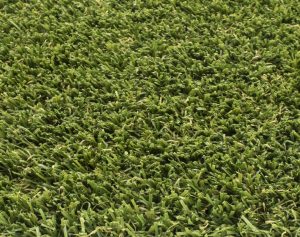Yes – you can lay artificial grass on soil, but not directly. To get a smooth, long-lasting lawn you’ll need to prepare the ground with the right base layers. Skip this and you’ll quickly run into problems: weeds, dips, poor drainage, and turf that doesn’t last. Below, we’ll walk you through the proper DIY method — the same groundwork our team uses on professional artificial grass installations.
Can You Lay Artificial Grass Straight Onto Soil?
Technically you can, but it’s not recommended. Soil alone won’t stay level, it holds moisture, and weeds will force their way through. A solid base made from compacted MOT Type 1 and a thin layer of sharp sand or grano dust gives your lawn stability, drainage, and a clean finish.
That’s why every artificial grass project in Manchester we install starts with proper ground preparation — it’s the difference between a quick fix and a lawn that lasts over 10 years.
Tools & Materials You’ll Need
Before you get stuck in, make sure you’ve got the right kit. A smooth, long-lasting lawn isn’t about cutting corners — it’s about having the basics ready. Here’s what you’ll need to prepare the ground properly and fit your grass with confidence.
- Turf cutter or spade
- Wheelbarrow
- MOT Type 1 hardcore
- Sharp sand, grano dust, or limestone fines
- Weed membrane
- Wacker plate / compactor
- Artificial grass rolls + adhesive / seaming tape
- Galvanised nails, staples, or glue depending on edging
Tip: Not got all the kit? Our installation teams lay over 500 lawns a year – ask us for a free survey and quote.
Step-by-Step: How to Lay Artificial Grass on Soil
Laying artificial grass on soil isn’t complicated, but each stage matters. The difference between a lawn that lasts a season and one that lasts a decade comes down to groundwork. Here’s the step-by-step method our team uses — the same process you can follow at home if you’re tackling a DIY install.
Step 1. Plan and Mark Out
Decide your finished height and edging. Timber is ideal for borders, concrete for hard edges. Order turf rolls (always allow 5–10% extra for cuts and joins).
Step 2. Remove Existing Turf & Soil
Strip out around 75mm of topsoil. Remove roots and apply weed killer if needed. This prevents regrowth later.
Step 3. Install Edging
Fit timber battens or smooth concrete around the perimeter. This gives you a secure edge to fix the turf into.
Step 4. Lay a Weed Membrane
Roll out geotextile membrane across the entire area. This prevents weeds growing through and extends the life of your turf.
Step 5. Build the Sub-Base
Spread 50–60mm of MOT Type 1 hardcore and compact it thoroughly using a wacker plate. A light sprinkle of water helps it bind together.
Step 6. Apply Sand Layer
Add a 10–15mm layer of sharp sand, grano dust, or limestone fines. Compact and screed level to remove dips. This creates a smooth bedding surface.
Step 7. Roll Out & Cut Grass
Unroll your artificial grass, making sure all pieces face the same pile direction for a uniform look. Trim edges neatly with a sharp knife.
Step 8. Join & Secure
Use adhesive and seaming tape to join rolls together. Fix edges to your timber frame with galvanised nails or staples, or use glue on hard edges.
Step 9. Brush & Settle
Brush the pile with a stiff broom to lift the fibres. Leave for 24–48 hours to let the grass settle into place.
What Happens If You Skip the Sand Base?
You’ll end up with an uneven surface that puddles in heavy rain. Weeds can break through, and the lawn won’t feel secure underfoot. That’s why our pet-friendly grass installations always include a proper base — dogs in particular will quickly expose a poorly prepared lawn.
FAQs About Laying Artificial Grass on Soil
Still got questions? You’re not alone. Homeowners often ask whether you can skip the sand, how long grass takes to settle, or if it’s safe for pets. We’ve pulled together the most common questions — with straight, honest answers based on our experience fitting over 500 lawns a year.
What is the best base for artificial grass?
MOT Type 1 hardcore topped with sharp sand.
Do you put sand under artificial grass?
Yes — a 10–15mm sand or grano layer provides levelling and drainage.
How long does artificial grass take to settle?
1–2 days before it feels firm and looks natural.
What’s the cheapest way to lay artificial grass?
DIY prep and supply-only turf. We supply grass from £12.50 per m² — with fast delivery across Bury and Greater Manchester.
How long will it last?
10+ years with proper installation. As Good As Grass offers a 10-year product guarantee.
DIY vs Professional Installation
DIY can save money, but it’s hard physical work and easy to get wrong. Professional installers deliver a better finish, longer lifespan, and stronger drainage. As we often say: we’re not the cheapest, because we don’t cut corners. But we are the best value if you want it done properly.
If you’d rather leave it to the experts, our team covers Oldham, Bolton, and the wider Greater Manchester area.
Want your new lawn to last? Let As Good As Grass handle the heavy lifting. We supply and install premium turf across Greater Manchester — with a 10-year guarantee. Get a Free Survey & Quote Today.



